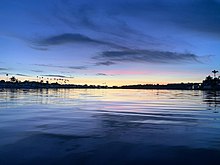Newport Back Bay
[1] It is a heavily residential area being in the wealthiest portion of both Orange County, California as well as the city of Newport Beach.
Sculpted by the Santa Ana River and carved during the Pleistocene Epoch, mammoth, bison, and giant sloth fossils have been discovered in sedimentary deposits of an older marine terrace.
In the California mission period, these villages declined from displacement and the area above the bay was used for grazing by cattle and sheep by the missionaries.
After another 1/4 mile further, past Big Canyon, water skiing was permitted in a circular course; due to ten years of constant lawsuits, enacted by concerned citizens, the State of California Department of Fish and Game designated the undeveloped portions of the Upper Newport Bay as an ecological reserve.
[3] Activities that are open to the public include kayaking, canoeing, picnicking, horseback riding, biking, hiking and bird watching.
[5] The Back Bay has a wide range of plants, birds, mammals, amphibians, reptiles, insects, and marine life.
[6] The Upper Newport Back Bay boasts one of the few remaining natural estuaries in Southern California.
The topsmelt, anchovy, and mullet are especially common in the area, feeding on the abundant population of plankton and detritus.
Along with a multitude of fish, plankton, and algae, a number of invertebrates occupy the marine zone of the Upper Newport Back Bay.
Some examples of birds that can be seen in the Back Bay are the light-footed clapper rail (Rallus longirostris levipes), the California least tern (Sterna antillarum browni), the Belding's Savannah sparrow (Passerculus sandwichensis beldingi), and the least Bell's vireo (Vireo bellii pusillus).
[11] The bluffs surrounding the bay are also home to three sensitive species, the California gnatcatcher, the San Diego cactus wren, and the burrowing owl.
[10] Because the Newport Back Bay watershed is such a dry area, the water demand is high and supply upkeep is of utmost importance.
To decrease the reliance on the Colorado River and Sacramento Delta, steps are being taken to educate people on how to conserve water.
[10] The Upper Newport Bay is one of the last remaining natural estuaries in Southern California; that is, it is a very lush area of land that is home to fish, birds, and other animals.
[4] This center’s main focus is to supply information on estuarine and marine biology through activities and lectures in a year-round program.
The Upper Newport Bay Ecological Reserve, which spans 752 acres, is one of the largest natural estuaries remaining in California.
